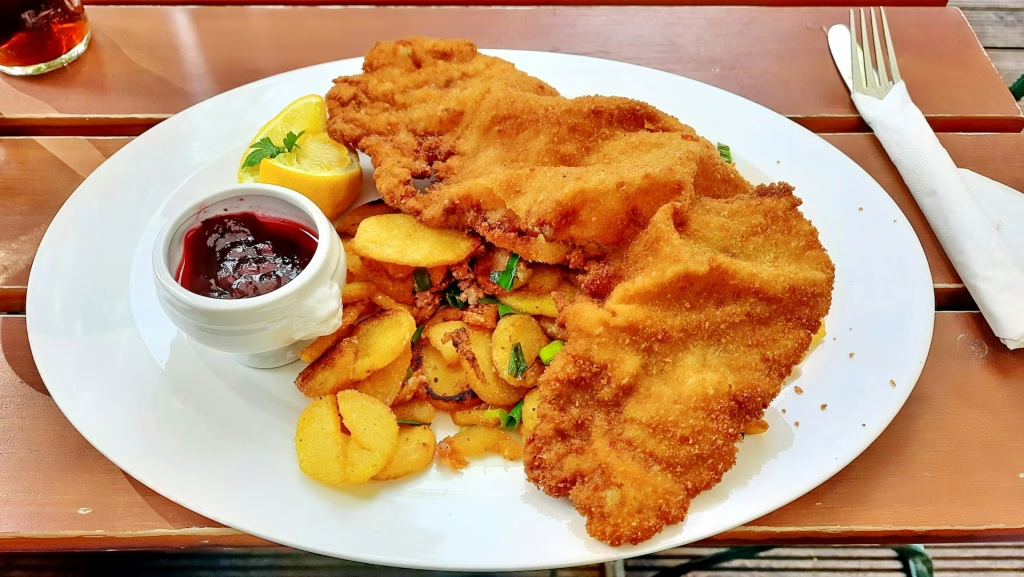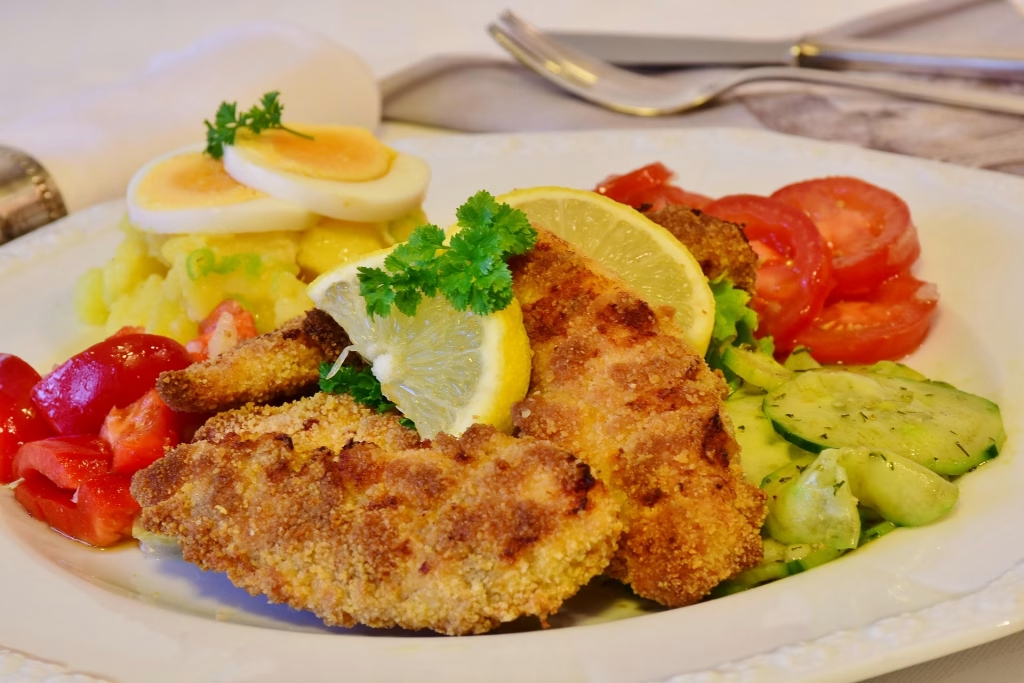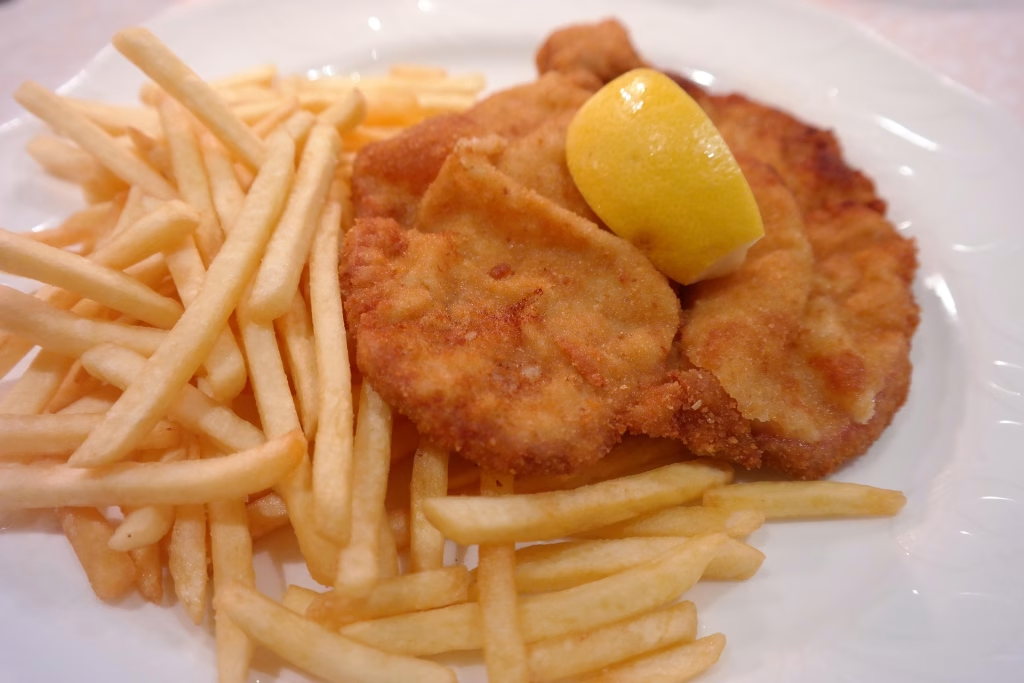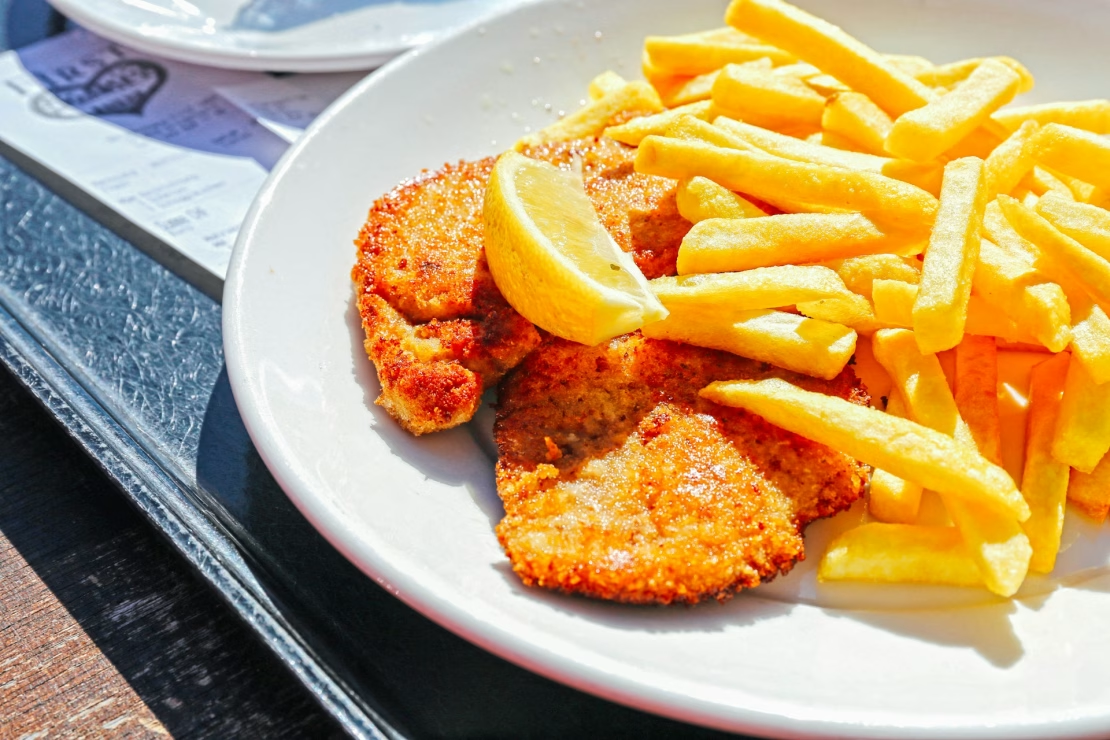Wiener Schnitzel is Austria’s most iconic dish— a thin, breaded, and fried veal cutlet that is crispy on the outside, juicy on the inside, and traditionally served with lemon, parsley potatoes, or cucumber salad.
Simple yet elegant, this golden delicacy represents the soul of Viennese cuisine and has earned global recognition for its irresistible crunch and clean, buttery flavor.
Table of Contents
Ingredients
For the Schnitzel:
- 4 veal cutlets (about 5–6 oz each, pounded to 1/4-inch thickness)
- Salt and freshly ground black pepper, to taste
- 1 cup all-purpose flour
- 2 large eggs
- 2 tablespoons milk or cream
- 2 cups fine, dry breadcrumbs (preferably plain and unseasoned)
- 1/2 cup clarified butter or neutral oil (sunflower or canola), for frying
- 2 tablespoons unsalted butter (for finishing)
For Serving:
- Lemon wedges
- Fresh parsley sprigs
Optional Side Dishes:
- Viennese cucumber salad (Gurkensalat)
- Austrian potato salad or parsley potatoes
- Lingonberry jam (traditional condiment)
Serves
4 servings
Step-by-Step Instructions
Step 1: Prepare the Veal Cutlets
- Place each veal cutlet between two sheets of plastic wrap or parchment paper.
- Gently pound with a meat mallet or the bottom of a heavy skillet until uniformly thin—about 1/4 inch thick.
- Season both sides lightly with salt and pepper.
Tip: Do not over-season. Authentic Wiener Schnitzel relies on the flavor of the meat and frying fat.
Step 2: Set Up the Breading Station
- In three shallow dishes or plates:
- Place flour in the first.
- Beat eggs with milk in the second.
- Place breadcrumbs in the third.
- Working one cutlet at a time:
- Dredge in flour, shaking off excess.
- Dip into the egg mixture, letting the excess drip off.
- Press into the breadcrumbs lightly—do not press hard. Let the coating stay loose and airy.
Authenticity tip: The light, puffy breading that separates slightly from the meat is a signature feature of a proper Wiener Schnitzel.
Step 3: Heat the Fat for Frying
- In a large skillet (preferably stainless steel or enamel, not nonstick), heat clarified butter or oil over medium-high heat.
- Add a little knob of butter for color and flavor.
The fat should be at 330°F to 350°F (165°C–175°C). It should shimmer but not smoke. Test with a breadcrumb—it should sizzle and rise immediately.
Step 4: Fry the Schnitzels
- Fry 1 or 2 cutlets at a time, depending on skillet size, so they aren’t crowded.
- Fry each side for about 2 to 3 minutes or until golden brown and puffed.
- Tilt the pan and gently ladle hot fat over the cutlet during frying to create the characteristic blistered coating.
- Use tongs to flip gently. Do not pierce with a fork.
- Transfer to a paper towel-lined rack. Keep warm in a low oven (around 200°F / 95°C) if needed.
Step 5: Serve Immediately
- Serve each schnitzel with a lemon wedge on the side and a sprig of parsley on top.
- Accompany with classic Austrian sides for the full experience.

Serving Suggestions
- Austrian potato salad (Erdäpfelsalat): A vinegary, warm potato salad with onions and broth.
- Gurkensalat: A refreshing cucumber salad with dill and vinegar.
- Lingonberry jam: Adds a touch of sweetness and tartness.
- Crisp green salad: With a light vinaigrette for balance.
- German-style spaetzle or buttered noodles: For a heartier meal.
- Austrian white wine or a light beer: Grüner Veltliner pairs beautifully.
Tips for Perfect Wiener Schnitzel
- Use veal: True Wiener Schnitzel is made with veal. Pork or chicken variations are delicious but technically not “Wiener.”
- Pound evenly: Thin and uniform cutlets cook quickly and evenly.
- Use dry, unseasoned breadcrumbs: Avoid panko or flavored ones.
- Do not press the breadcrumbs: A light coating allows puffing.
- Use enough fat: Shallow fry with at least 1/4-inch depth.
- Ladle hot fat: Helps create the puffed texture and crispiness.
- Don’t overcrowd the pan: Fry in batches for best results.
- Clarified butter = best taste: Adds rich flavor and withstands higher heat.
- Serve immediately: The breading softens quickly if left to sit.
- Avoid sauces directly on schnitzel: Moisture ruins the crisp crust.

Healthier Alternatives
- Bake instead of fry: Brush with oil and bake at 400°F until golden and crispy.
- Use chicken or turkey: Leaner than veal or pork.
- Use whole-wheat breadcrumbs: For added fiber and nutrients.
- Pan-fry with minimal oil: Use a nonstick pan and a light spray.
- Air fryer: Cook at 375°F for 10-12 minutes, flipping once halfway.
Creative Variations
- Schnitzel Holstein: Topped with a fried egg, anchovies, and capers.
- Pork Schnitzel: A common and economical variation.
- Chicken Schnitzel: Loved globally; lighter and kid-friendly.
- Stuffed Schnitzel (Cordon Bleu): Filled with ham and cheese.
- Herb breadcrumb mix: Add fresh parsley or thyme to the breadcrumbs.
- Parmesan breadcrumb mix: For an Italian touch.
- Schnitzel sandwiches: With brioche buns, mustard, and greens.
- Mini schnitzels: Great for party platters or sliders.
- Vegan schnitzel: Made with seitan or eggplant slices.
- Gluten-free schnitzel: Use almond flour or GF breadcrumbs.

Common Mistakes to Avoid
- Using meat that’s too thick: Results in uneven or raw centers.
- Skipping the pounding step: Reduces tenderness.
- Pressing breadcrumbs too firmly: Leads to a dense, soggy coating.
- Crowding the pan: Lowers oil temperature; soggy results.
- Not using enough oil or fat: Won’t get crispy, airy texture.
- Using flavored breadcrumbs: Masks the delicate flavor of the schnitzel.
- Frying at incorrect temperature: Too low = greasy; too high = burned.
- Neglecting to rest after frying: Causes sogginess if stacked.
- Using sauces directly on schnitzel: Makes it mushy.
- Serving cold or late: Breading goes limp after 10–15 minutes.
History of Wiener Schnitzel
The Wiener Schnitzel, while now synonymous with Austrian cuisine, has a debated origin. The term “Wiener” means “Viennese,” and by Austrian law, only a veal schnitzel can bear the full name. The dish made its formal appearance in Viennese cookbooks in the 19th century but likely evolved from earlier European breaded meat traditions.

One popular theory links its arrival in Austria to Field Marshal Radetzky, who brought back a similar Italian dish—cotoletta alla milanese—from his campaigns in Lombardy during the 1800s. Austrian chefs adapted it using local techniques and clarified butter, creating a crispier and lighter version.
The schnitzel’s popularity quickly soared, especially in post-war Austria, becoming a beloved staple in homes and restaurants alike. Today, Wiener Schnitzel represents not just a national dish but a symbol of Austrian identity, with a legacy of culinary refinement and comfort.
FAQs About Wiener Schnitzel
- What is Wiener Schnitzel made of?
It’s made from veal cutlets, pounded thin, breaded, and shallow-fried. - Can I use pork instead of veal?
Yes, but it must be called “Schnitzel Wiener Art” in Austria, not “Wiener Schnitzel.” - What’s the difference between schnitzel and cutlet?
A schnitzel is always breaded and pan-fried; cutlets can be grilled or sautéed without breading. - Why does my schnitzel breading fall off?
Likely from pressing too hard or insufficient egg adhesion. Don’t overcrowd or flip too early. - Can I prepare Wiener Schnitzel ahead of time?
Bread ahead but fry just before serving. Reheating ruins the texture. - What oil is best for frying?
Clarified butter gives the best flavor. Otherwise, use neutral oils like sunflower or canola. - Is it okay to freeze schnitzel?
Yes. Freeze breaded but uncooked schnitzels; fry from frozen, adding 1-2 minutes. - What sides go well with Wiener Schnitzel?
Potato salad, cucumber salad, lingonberry jam, or lemon wedges. - What is the best wine pairing?
A dry white like Grüner Veltliner or Riesling, or a light Austrian lager. - Can I use an air fryer?
Yes. Cook at 375°F (190°C) for about 10-12 minutes, flipping halfway.
Wiener Schnitzel is the golden crown jewel of Austrian cuisine, a dish that embodies refinement, tradition, and comfort. With its delicately crisp exterior and tender interior, it delivers a masterclass in simplicity done right. Whether you’re crafting it with veal for a true Viennese experience or experimenting with chicken or pork at home, the result is always deliciously satisfying. Mastering Wiener Schnitzel means embracing attention to detail—thin, even cutlets, a feather-light coating, and just the right amount of frying finesse. Once you’ve made it, you’ll understand why it’s beloved around the world.


